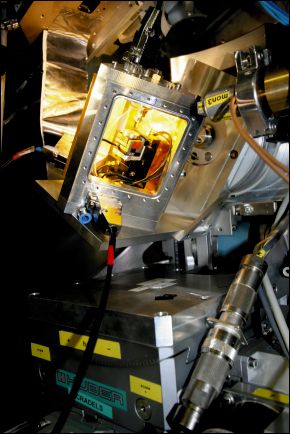- Home
- Users & Science
- Scientific Documentation
- ESRF Highlights
- ESRF Highlights 2008
- Methods and instrumentation
Methods and instrumentation
Introduction
Instrumentation development and the deployment of new methodology are fundamental to synchrotron radiation research. At the ESRF, close collaboration between the instrumentation support teams and the beamline scientists has been the traditional source of most developments. In the future, the exploration of new techniques, the need for instrument integration, the quest for stability, automation, and user-friendly operation will call for an even closer collaboration between beamlines and developers.
A new division, the Instrumentation Services and Development Division, ISDD, will gather together support groups presently distributed among the Experiments, Computer Services and Technical Services Divisions in view of the Upgrade Programme, which will dedicate the greatest part of its funding to new beamlines and instrumentation development. The new division, together with a newly introduced project management system, will permit an enhanced effort, capable of responding to the instrumentation challenges set by the Upgrade Programme.
The main themes of instrumentation development for the next few years will be based on the integration of very different technical domains and the use of the most recent discoveries in nanotechnology. Integration of different characterisation techniques into the crowded environment surrounding the sample is one of the challenges of the entire programme. In 2008, an important breakthrough was made in this direction: a beamline specific atomic force microscope (AFM) was developed and has been tested on selected ESRF beamlines. The microscope is designed to visualise and position nanostructures, track the beam profile, and manipulate and exert force on the sample while doing X-ray experiments. In one of the first experiments, it has made the measurement of the Young’s modulus possible for a single nanodot [1].
 |
|
Fig. 150: The atomic force microscope installed in the end station of beamline ID01. The AFM is used to visualise both the beam and the sample and to manipulate the sample (Courtesy O. Dhez). |
The small dimensions of the atomic force microscope are advantageous for its installation in the beamlines, facilitating its integration (see Figure 150). Smaller devices naturally offer much higher cut-off frequencies, and hence faster responses. For these reasons they will be important players in the instrumentation theatre of the next few years. The first contribution in this chapter dedicated to methodologies and instrumentation, shows how a simple silicon cantilever can be used as a fast X-ray chopper. This simple experiment opens the way to the use of fast responding MEMS and NEMS in synchrotron radiation technology. Miniaturisation is also the driving force of the second contribution where a laser beam is used to drill small holes in the gaskets of diamond anvil cells. The next two contributions are relevant to X-ray optics, one suggesting a method for easier retrieval of information on layered systems and the second showing again that silicon technology applied to synchrotron radiation can provide easy to use X-ray interferometry up to 100 keV. The last two contributions illustrate the range of instrumentation advances made possible by the close collaboration between the Macromolecular Crystallography Group and the various support teams. In the past years this close collaboration has led to the development of beamline automation that earned the Bessy Innovation Award for the teams involved. Their work has permitted the launch of remote access to the macromolecular crystallography beamlines, this is described in the final article.
F. Comin
Reference
[1] T. Scheler, M. Rodrigues, T.W. Cornelius, C. Mocuta, A. Malachias, R. Magalhães-Paniago, F. Comin, J. Chevrier, and T. H. Metzger, Appl. Phys. Lett. 94, 023109 (2009).



